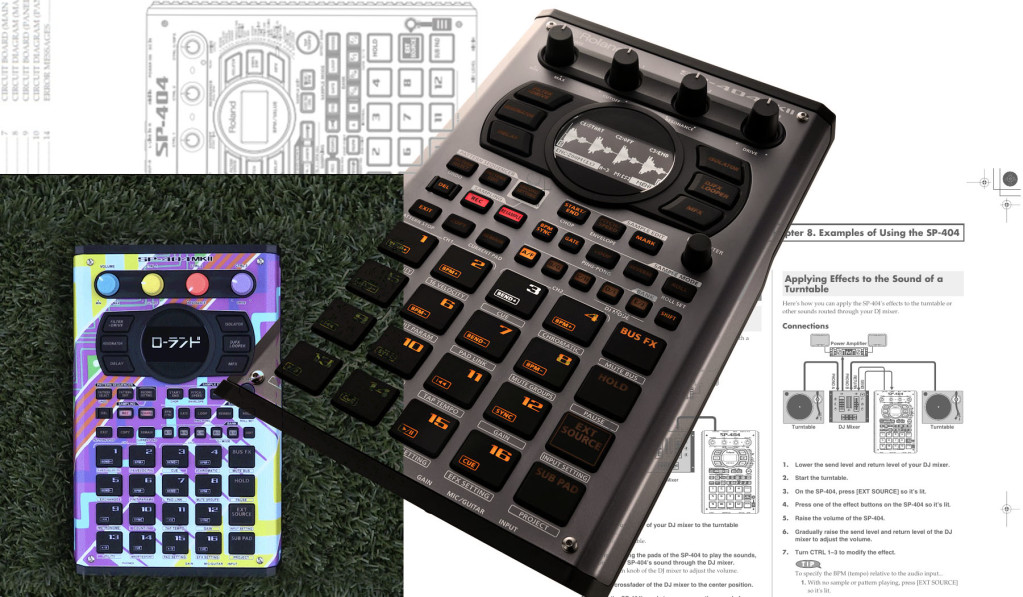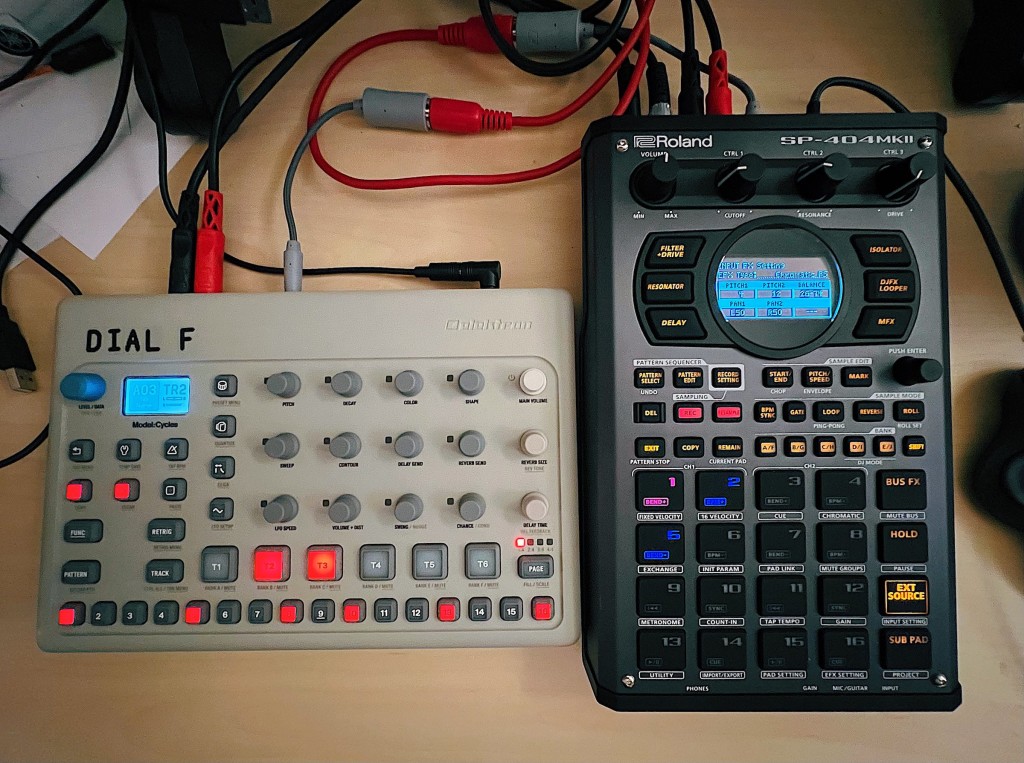It’s 404 Day – in the more-overlooked of the Roland-themed faux holidays! And what way better to celebrate than with some sound tips from CDM editor-at-large David Abravanel. They add to the evidence that the SP-404MKII is capable of way more than lo-fi beats, just in case you weren’t already among the converted.
It’s way more fun than April Fool’s – no joke.
Happy April 4th! You might remember me as the guy who said that the SP-404mk2 was the most capable electronic instrument I’d ever owned, given the cost and form factor. And I stand by it – let’s celebrate this tweaky box and its legacy.

It does other fi-s too!
SP-404MKII is unfairly cast as a kind of “lo-fi chill beats” machine only. Part of this is understandable – J Dilla, Madly, MF DOOM, Teebs, Odd Nosdam, Panda Bear – there’s a litany of chill/lo-fi heroes associated with the SP line as a primary instrument. And their music is great! But there’s a lot more you can do. Here are some of the things I’ve found uniquely fun and strong with the SP-404MKII:
Jungle: this thing is a beast for working with breaks, and especially with significant time/pitch editing. The new screen makes it very easy to get precise edits, and the chop functions let you quickly split up breaks into pads to play back for new rhythms. The ability to keep everything synced to the master pattern BPM is huge too! And the time-stretching options are great – you can enable some of the smoother ones for sounds you want to sound more natural, use vinyl mode (pitch/time are coupled, similar to the Elastique RePitch algorithm in Live etc.), or purposefully go for extreme levels to get old Akai-style graininess.
A little junglism featuring an ol’ CDM classic in the Meeblip Anode.

Sidenote: for the real voltron you’re going to need another affordable box to go with it – namely the Elektron Model:Cycles. You’ll find the Model:Cycles used alongside the SP-404MKII in all of my new sketch tracks in today’s post.
Especially if you’re looking for an affordable setup, you can’t go wrong complementing the SP-404MKII with the Model:Cycles. You can generally get an SP-404MKII now for ~$550 new or ~$450 used, and you can get a Model:Cycles for ~$300 new or ~$270 used, so let’s say you’re looking at spending $700-850 for the whole setup.
Go IDM: (we can use that acronym again as long as we reject the elitism yeah?) style with the effects. The SBF effect alone could also be called the Errorsmith-izer for its flexible tail and frequency options. Listen below and you can further hear how this works especially well in combination with the Model:Cycles – tweaking on both is also just tremendous fun:
Ed. We could replace IDM with Braniac Propellerhead 90s Nonsense, BP9N. No?
Techno/house with lots of pressure and grunginess comes naturally here. Borrowing a phrase from Ned Rush, you’ll often be tempted to compress it like an idiot (CILAI) with the SP-404MKII – and you absolutely should, as in my sketch below:
[CLOSEUP TO 303 VINYL SIM ON SCREEN GOES HERE]
If you aren’t massively overusing this effect, do you even 404 m8?
Go off-grid! It’s easy to create beats that have their own swing and feel – similar to how Burial works. Start by playing out a beat you like, then use the skipback feature to carve out a loop. From there, it’s easy enough to keep adding to it with resampling, as I’ve done for the sketch below:
Where clean meets wobble. Try combining clean sounds with the wobbly/noisy ones. Another great use case with the Model:Cycles, the sketch below features M:C chord run through the SP-404 OG vinyl sim, while the M:C hats/percussion remain relatively clean and cutting and the sampled 909 kick and snare get a little pressure added from the SP-303 vinyl sim compressor.
And uh…lo-fi hip hop. Look there’s no question it’s fun, and like its ancestors the SP-404MKII really excels in this realm. Especially when you’re throwing effects in and out – forgive my timing in the example below.
Before you jump in
Obviously the SP-404MKII is not perfect – though it’s pretty close. Part of why I include the “for the cost” caveat in my assessment is that, without question, there’s more expensive hardware out there that can do more.
Here are some things to bear in mind with the SP-404MKII:
Ins and outs. The I/O is limited to stereo 1/4” in/out, single 1/8” TRS MIDI in/out, stereo 1/4” and 1/8” headphone out, and 1/4” mono mic in with a one-knob preamp and mic/guitar switch to determine input gain. Cleverly, however, they’ve included the ability to use the headphone outs as a cue channel in DJ Mode. That said, this isn’t a festival of I/O like, say, the MPC4000. Also, if you’re sampling from a turntable, you’ll need to have an external phono pre-amp and be able to convert from RCA to 1/4”.
The I/O limits also mean that you cannot run an effects loop, as you’ll end up recording feedback in. It’d be great to have the option to use the cue function for this, such that you could resample through an external effects unit.
There can be only one. Pattern. If you aren’t familiar with the SP-x0x series, this has been one since the beginning: one pattern at a time can be played. To get a sense of how this differs, you might think of the MPC, where traditionally you can have multiple “tracks” on a pattern that can include any of the pads, so you could feasibly have different sequences involving the same sample pads within the same pattern as different tracks. If, for example, you want to playback a pattern and have the hi-hats differ, there’s no “fill” function – you’ll either need to have a separate loop to playback as a sample, or a separate pattern.
The great news here is that copying patterns – and specifying which specific pads you want to copy – is extremely easy and quick.
TR-REC, not P-LOCK. The TR-REC step sequencer is very robust, but for my money, nothing beats the Elektron boxes when it comes to step sequencers. You can record effect motion and specify pitch/swing/volume per note in TR-REC, but beyond that, there isn’t anything like conditional or parameter locks. That said, the SP-404MKII is not a synth – and it’s pretty easy to resample the effects performances you might want.
Ed. Okay, counterpoint – I love the simplicity of TR-REC, so it’s hard to call this a shortcoming, especially because I’d contrast that with the complexity of, uh, everything else –
Shortcut school is in. I’ll admit there’s a bit of a learning curve in getting the most use out of the SP-404MKII in getting the hand of the shortcuts and generally “404 thinking”. That said, I honestly don’t think it’s all that complicated – you can master the whole box within a weekend easily. Then again, I also get an absurd amount of joy from memorizing button combos and to work faster, so perhaps I’m downplaying it.

One more reminder of what’s so great about the SP-404MKII and Model:Cycles, because it looks cool in fact-sheet format. A meta groovebox with:
- Up to 6 tracks of FM synths that can be customized for kick, metal, snare, perc, tone, and chord algorithms.
- Up to 6 tracks of up to 64 steps of Elektron sequencing, with the conditional locks allowing for dense algorithmic customization.
- 7 total effects slots
- Dedicated delay (FM synths only)
- Dedicated reverb (FM synths only)
- Input FX bus (FM synths only)
- 4 globally assignable FX busses (one of 41 FX options can be used with each)
- A sampler with 16 GB onboard memory, space for 16 projects of up to 10 pad banks and up to 160 sounds each.
- Sampler patterns that can be sequenced with detailed micro-timing either in step or real-time mode, up to 160 sequences per project.
- Advanced options for pitch-shifting and time-stretching of samples.
- Pad mutes available for both the 6 FM voices and for any of the sample pads.
- DJ mode for playing back recorded samples, can also be played alongside FM synth with BPM sync (including small pitch/time bends)
There you have it!
We’re not done yet, though – more to learn from this little box. Stuff you’d like to see? Shout out in comments.




